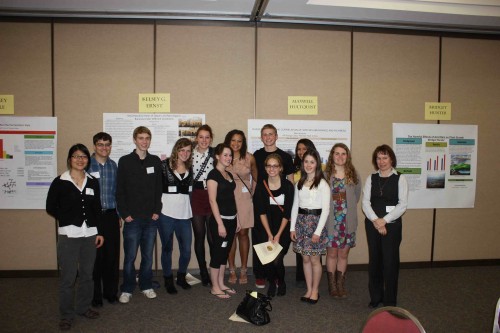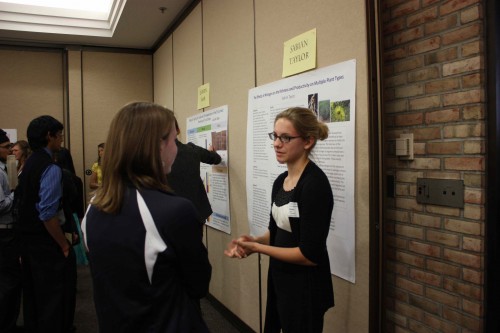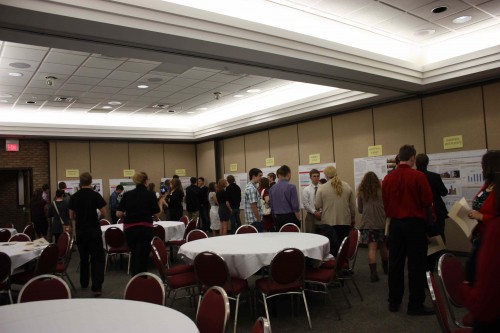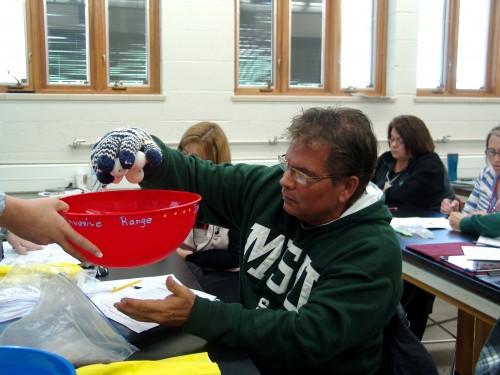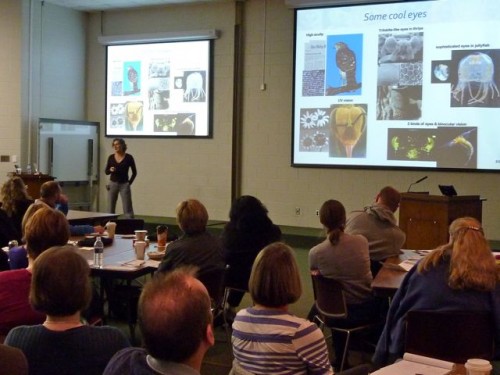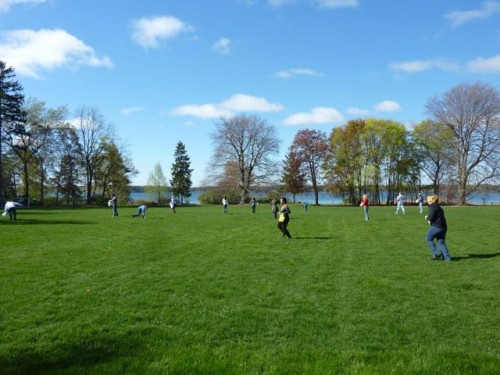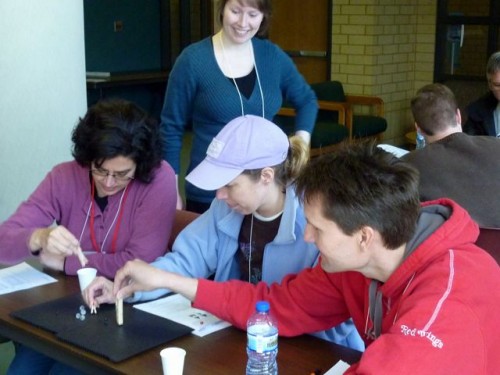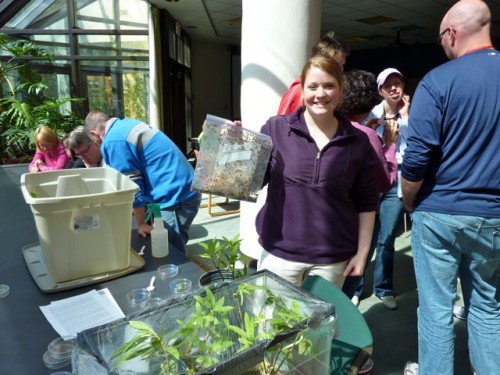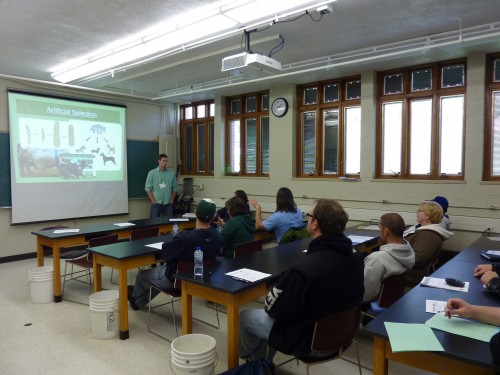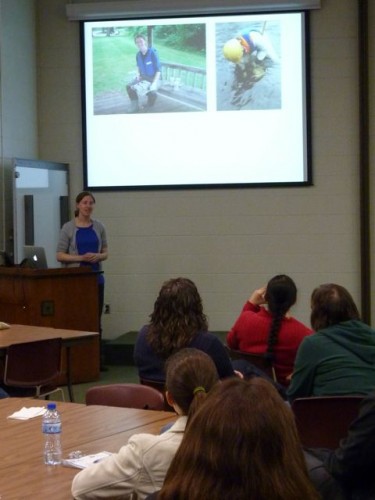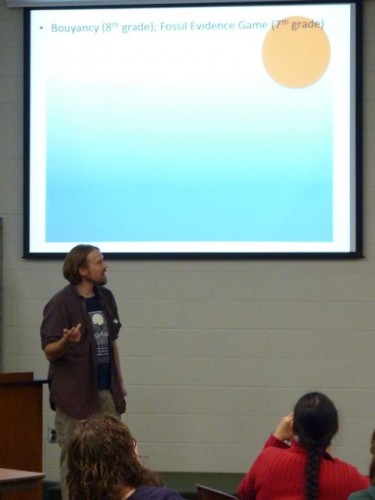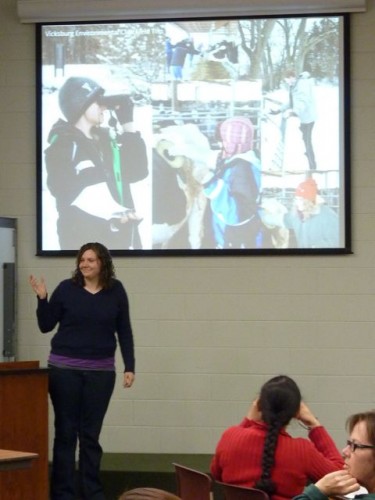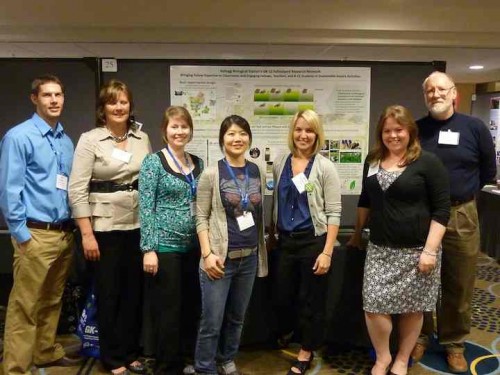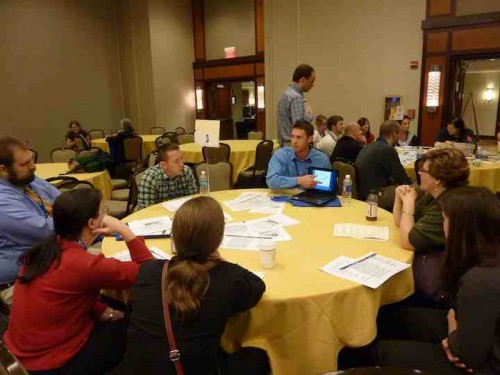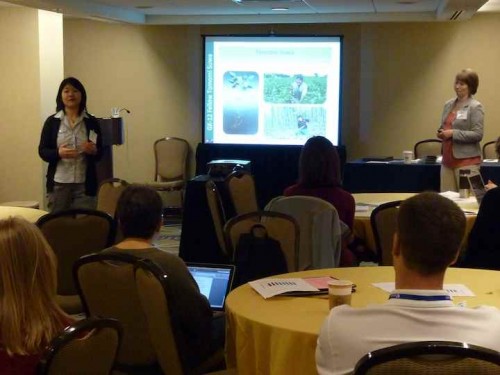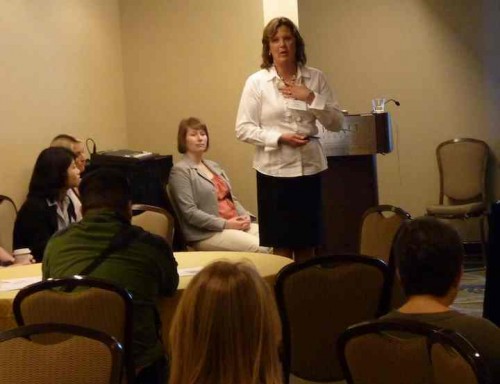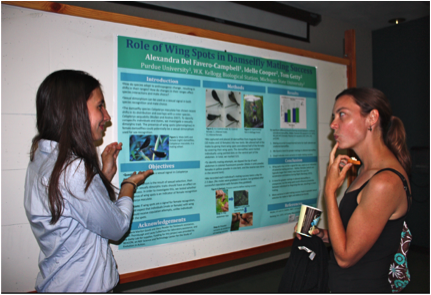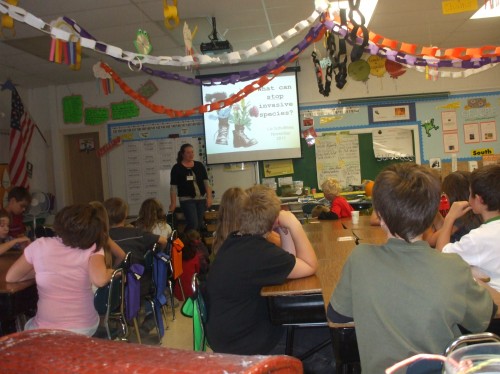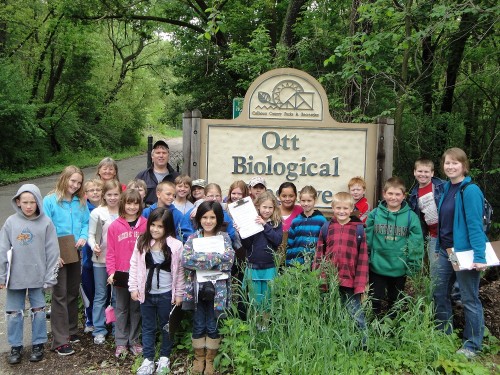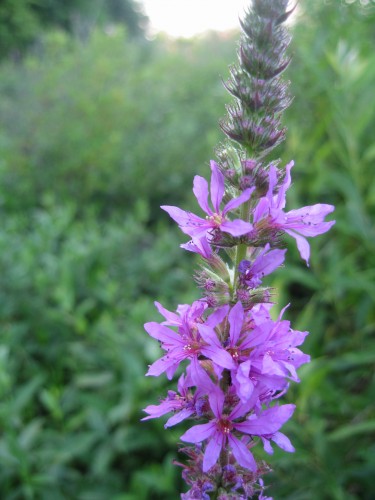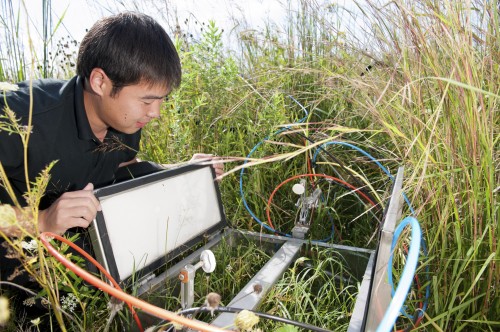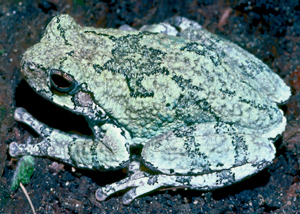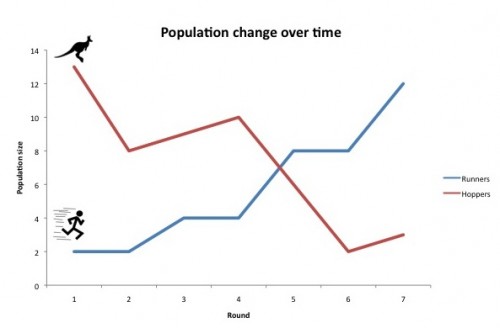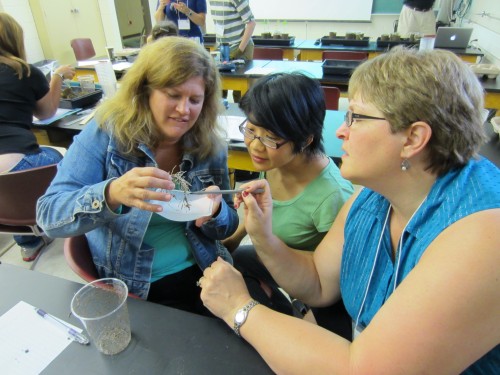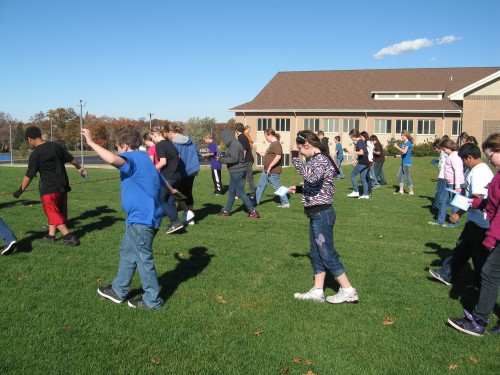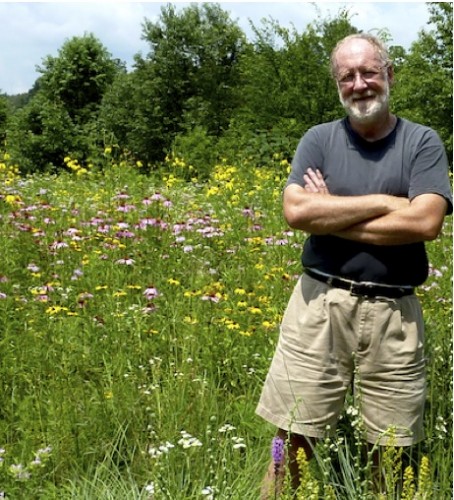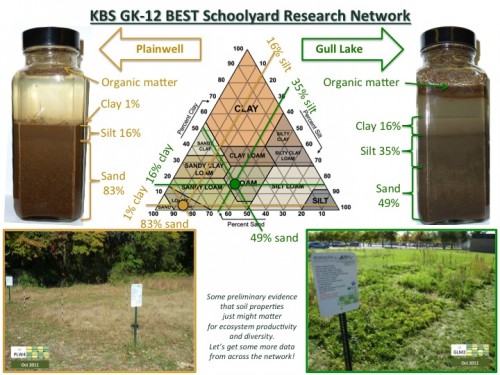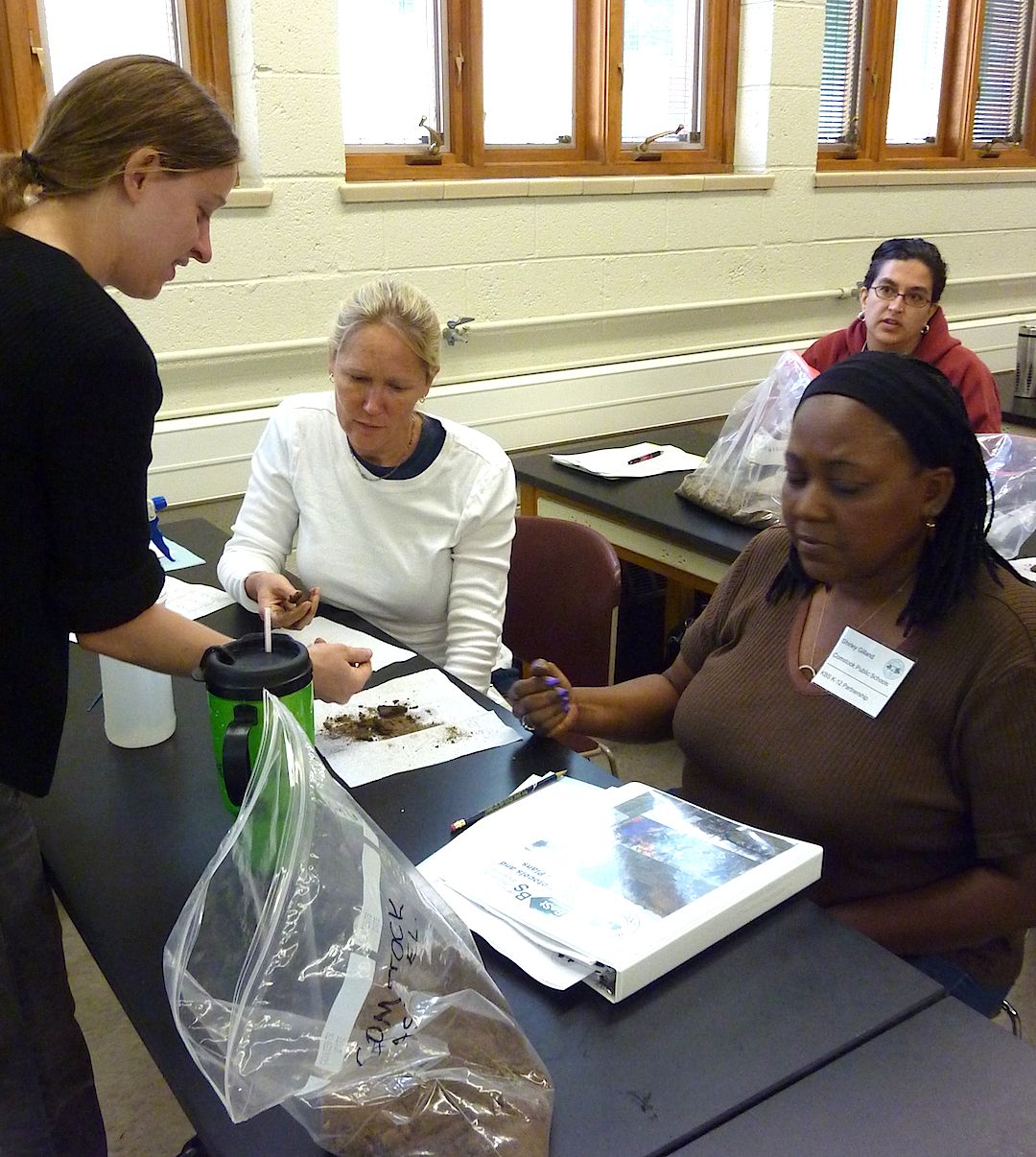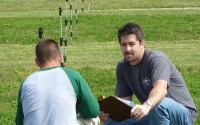Tyler just finished up the first of his two years as a GK-12 Fellow. This year, he’s been working in Gull Lake Middle School with two teachers, Kim Clancy and Jennifer Boyle. Read up on some of his work, including work on our BEST plots research network, on page 7 of the district’s newsletter (below). This is the second time Tyler made the news in the Gull Lake Communicator- they must really like him over there!
Fellow Tomomi Suwa and Sandy Breitenbach’s AP Biology Students recently travelled to Grand Valley State University to present their 2011-2012 research projects. Here’s the scoop from Tomomi…
April 25th was a big science day for 14 students from Plainwell high school. They each presented a poster on their independent project at the Michigan High School Math and Science Symposium at Grand Valley State University. Among 40 other presenters from Southwest Michigan schools, the students from Plainwell represented their school very well.
These students are from Mrs. Sandy Breiteinbach’s AP Biology class and since last September, I’ve been working closely with them to go through the entire process of science including picking interesting questions, designing an experiment and analyzing the data. They each came up with creative projects such as the effects of spotted knapweed on native plant species, differences in decomposing rates between organic and conventional fruits, and the potential effects of watermill pollution on invertebrate organisms in the Kalamazoo River.
At first, they looked nervous about presenting their work in front of other high school students and teachers. But they quickly warmed up and seemed to enjoy the experience. I was very proud to see them complete their independent project and to share their findings to their peers. I think the Math and Science Symposium brought the year of independent projects to a successful close. Congratulations!
Many invasive species do not start to invade as soon as they are introduced into a new area; there is a “lag time” in most invasions where scientists predict they are evolving to their new habitat and waiting for beneficial genes to arrive, either through mutation or further introductions of new individuals from their native range. Through an interactive game, students will learn how evolution might create an invasive species. The game demonstrates the basic components of evolution (variation and selection) and how they can cause an introduced species to become invasive and out-compete native species.
At the conclusion of the lesson, students will be able to understand the basic concepts of evolution and biological invasions including:
- Evolution by natural selection
- Three factors required for evolution by natural selection to occur (variation in trait, fitness differences, inheritance)
- Source of variation (mutation, recombination and migration) and how these differ between native and invasive species
- The definition of an invasive species
- How evolution by natural selection can facilitate an invasive species
Resources:
Lesson plan and game created by GK-12 Fellows Tomomi Suwa & Elizabeth Schultheis and Teacher in Residence Marcia Angle, 2012
By Guest Blogger and KBS GK-12 Friend Joelyn de Lima
April 11, 2012 was a day loaded with fun at KBS. Our GK-12 Fellows outdid themselves developing interesting and informative lessons and games that addressed the topic for the day “Evolution and the Biodiversity of Life” from different viewpoints. Topics ranged from the evolution of beak shape to mimicry and invasiveness.
The day began with Tom Getty giving a brief update we call “The State of the BEST Plots”. Most of our plots are in a good shape, but a few had to be visited by the Round-Up fairy!
The speaker of the day, Jenny Boughman, took over from Tom and spoke on the topic “The Evolution of Complex Adaptations: The Eyes Have It!”. She talked about how evolution works by taking existing structures and changing them bit-by-bit. Since eyes do not fossilize, one way of studying their evolution is to observe present day organisms that have eyes of varied complexity. So first we have Eyespots, which can detect light but not the direction of incident light. These are found in organisms such as Planaria and Euglena. Eyespots gave way to Cup Eyes. Cup eyes can perceive the direction that light comes from, which aids movement, but they cannot form images. These are found in certain marine worms.
The next level of complexity is seen in Pinhole eyes. Organisms such as Nautilus have pinhole eyes that form blurry, low-resolution images and can also detect directionality and movement. This takes us to the next level, which are Fluid-filled eyes. Along with a simple lens, this allows organisms like snails to see clearer images and detect motion. The last and most complex level is the Camera type eye, the eyes that allow you to read this. The camera type eye enables organisms to form finely focused images, evaluate distance, movement, speed, shape, texture, color and to guide its own movement. Dr. Boughman also spoke about three eye related genes that help in tracing the points in the phylogenetic tree at which the eyes evolved different levels of complexity.
After a short break, the first Concurrent Sessions started. In Geeked about Beaks, Alycia demonstrated how bird beaks might evolve in response to available food resources. She used different sized clothespins (the beaks) and beads (food). In her session on Adapting to your Environment: Tanning, Camouflage and Evolution, Jennifer spoke about increasing students’ understanding of the word “adaptation” and the difference between how biologists use the word and it’s more colloquial meaning (change within a generation). During the session Carbon Time Systems and Scale, Jenny explored activities which relate to the soon-to-be-released Next Generation Science Standards. Michael and Kate were back with another fun game in The Hunger Games. They used sets of colored Easter eggs to demonstrate how mimicry behavior is exhibited by species to deceive their predators or prey and how the frequency of mimics depends on the costs and benefits of being a mimic.
During the second set of Concurrent Sessions we had an Aphid Buffet in the Terrace Room hosted by Melissa (former GK-12 Fellow). With the help of over a thousand ladybeetles, her session tested the defensive strategies of Aphids. In Carbon Time Ecosystems, Hannah had her audience become carbon atoms which moved between different carbon pools in an ecosystem. Hannah’s game demonstrated how various processes impact the pools and fluxes of carbon. Tyler’s session “If it Ain’t Broke, It Won’t Get Fixed” had us build phylogenetic trees of shoes and local botanic samples collected at KBS. He focused on teaching about common descent and traits that are shared because of common ancestry – as opposed to analogous. Finally, using tons and tons of ping pong balls, Liz and Marcia conducted a session called Evolving to Invade in which they demonstrated the types of evolution that lead species to become invasive, and how invasive species interact with other organisms in new habitats.
After a delicious lunch, we went fishing with Christine and Nick. In their session on Humans as a Selective Force, they used a fishing simulation to discuss how humans act as selective forces, for instance, changing the size and personalities of commonly fished species. Meanwhile in her session What Time is It? When Plants Bloom and Die, Leila explored the effect of changes in environmental temperatures (climate change) on plant phenology. Her audience froze leaves to study the effect of – well – freezing. In The wonderful World of Biosynthesis Jonathan explored how organisms reorganize organic molecules within themselves. He used molecular models and charts (including a fabulous one of a cow) to demonstrate flow of materials through a food chain. Finally, during Fertilization Protocol for the BEST plots, Leilei brought us back to the BEST plots and explained a simple fertilization protocol for students to perform on their own BEST plots. The audience also went outdoors and practiced by spreading Osmocote on a plot just like our BEST plots. We should see a patch of really lush lawn soon!
A new feature of this Workshop was the session ‘What did my Fellow do this year…. Outside of the Classroom?’. During this session, each Fellow had an opportunity to share major achievements that occurred this year in their research. We were pleased to hear more about grants from the National Science Foundation, papers submitted to scientific journals, completed experiments, and gains in communication and confidence.
And thus ended a truly fun-filled day!
 Here you will find the protocol for fertilizing the GK-12 BEST fertilization treatment plots. We want to test hypotheses about how fertilization influences plant productivity and diversity and how fertilization treatment effects might relate to soil properties and to invertebrate abundance and diversity on the plots. Each block has 8 plots, 4 of which will receive fertilization. Fertilization begins in year two after establishment (Spring 2012).
Here you will find the protocol for fertilizing the GK-12 BEST fertilization treatment plots. We want to test hypotheses about how fertilization influences plant productivity and diversity and how fertilization treatment effects might relate to soil properties and to invertebrate abundance and diversity on the plots. Each block has 8 plots, 4 of which will receive fertilization. Fertilization begins in year two after establishment (Spring 2012).
Report from Tom: Nick, Marcia, Alycia, Tomomi, Robin and Liz presented and represented our GK-12 Project at the 2012 Annual Meeting for GK-12 Project Teams, held at the Hyatt Regency on Capitol Hill, March 16-18. I cheered them on, took pictures and took great pride in they way they represented all of us. Nick’s roundtable discussions about fostering quantitative reasoning skills were well-attended and well-received. Our BEST Team presentation on Building Long-Term Research Projects and Collaborations was a big hit, even though it was at the worst possible time (early Sunday morning) and location (a room hidden behind the bar). Participants were very enthusiastic about our presentation and activities and full of questions and suggestions. It was especially gratifying to learn that other projects are studying our website and adopting some of our innovations. There were 103 projects represented at the meeting and many of them are doing very interesting things, but I liked ours the BEST! I also liked the crab cakes at Clyde’s the best, but the crab cakes at My Brother’s Place were very good and much cheaper. Additional information about the meeting, the agenda and abstracts of presentation are available at http://www.gk12.org/meetings/ . At out GK-12 publications page (http://kbsgk12project.kbs.msu.edu/publications/ ) there are links to our poster (http://kbsgk12project.kbs.msu.edu/publications/ ) and the slides from our presentation (http://kbsgk12project.kbs.msu.edu/wp-content/uploads/2011/02/GK-12-annual-meeting-workshop-2012-reduced.pdf ). Now it is time for me to step out of the way and let the BEST Team share their experiences.
Report from Nick: Attending my first GK-12 conference was both exciting and encouraging. I was fortunate to interact with numerous partner teachers and fellows who were bubbling over with enthusiasm and motivation to improve science education. This was especially true at my roundtable discussions on fostering critical thinking and at our BEST team presentation.
During my roundtable discussions I explained a lesson structure that I have created that focuses on developing the core critical thinking skills required to perform many essential tasks in science, such as engaging in argument from evidence and making claims and supporting them with evidence. My audience engaged me in fruitful discussion and provided me with ample positive feedback and insightful suggestions throughout, which left me feeling that my presentations were a success.
Despite The BEST team’s presentation time and room placement, we attracted an audience that was so engaged with our presentation on building long-term research projects that we ran out of time while trying to address all of the positive comments and feedback we received. It seemed that each time that we transitioned from one speaker to another, a group discussion would spontaneously occur where several audience members would ask questions and praise our work. In fact, we had several participants stay behind after our presentation ended to continue to discuss our project further with us, which to me is always a sure sign of genuine interest in a presentation.
Report from Robin: This year I attended my third (and probably last L) GK-12 Annual Meeting. This was the second time our project has been chosen to present a workshop for PIs, Fellows, and K-12 Partner Teachers in attendance. I was honored to share our experiences, and your hard work over the last two years, building the BEST Research Network, and I truly enjoyed watching our Fellows shine as they described their own research and how they bring their work to the BEST Research Network and K-12 classrooms throughout SW Michigan. They are amazing! But, you all know that already. There is definitely a lot of enthusiasm in the GK-12 community about the work we are doing and the opportunities that long-term research networks offer for doing open-ended inquiry in K-12 schools. Keep up the great work, everyone. It’s an honor to represent you!
Marcia and I attended a fun workshop to learn about using 1 minute videos to quickly introduce teachers to the content included in lessons that GK-12 projects post on their website – the idea is that short videos are not only engaging, but save teachers the hassle of reading through paragraphs to text to figure out whether they want to use a particular lesson. We think this would be a great way to introduce our BEST plots protocols, so be on the look out for quick videos that introduce the Biomass and Biodiversity, Soils, and Landscape-level protocols this summer. You could even use these to introduce the protocols to your students and get them excited about going outside. We’ll keep you posted…
Report from Liz: I feel very lucky to have been able to attend the final GK-12 conference – I know our project has accomplished great things so far, and it was great to learn about the amazing work others are doing as well. It was clear everyone had ample enthusiasm for their work and that the connection between the universities and K-12 classes will continue long after funding runs out for this program.
During our presentation, it was easy for me to share the ways in which being a GK-12 fellow has helped me in my graduate career. Not only has my time as a fellow given me more confidence as a public speaker and educator, but also more clarity in the main ideas behind my dissertation research. It was a lot of fun to present my Invasive Species Game with the audience, and to share how it related to my research and basic ecology principles that teachers are discussing in their classrooms. I received many great suggestions of ways to expand the reach of my Invasive Species Game, and I can’t wait to try them out at our next KBS Workshop!
Report from Alycia: Our presentation went amazingly well! Some participants said it was the best workshop they attended all weekend! Another GK-12 project is eager for us to publish the Data Nuggets because they use them for their project. Everyone also loved the invasive species game Liz presented. Definitely a success!
I attended one session about skipping lecture and using active learning techniques in the classroom. It was great to see familiar and new techniques in action. One useful tool was constructivism – having students construct their understanding instead of having information given to them. The presenter used an example with significant figures where she providers her students with a series of examples and gets them to construct the rules for determining the number of significant figures. I also attended a session on evaluating GK-12 projects. One idea I’m keen to try out is to have all of the fellows share their research gains at the next workshop. We can do a “year-in-review” both for our experiences in the classroom as well as our progress on our research. It would be great to share this with the teachers and put our communication skills to the test.
It was great to interact with everyone at this conference that was so enthusiastic about improving science education. It makes me feel good about the work we do in the classroom. I can also see the benefits of our professional development and how that will prepare us for careers in science.
Report from Tomomi: This was my first time participating in the GK-12 conference and I had a lot of fun sharing our GK-12 project with an enthusiastic audience. During our 75 minute presentation, six of us each spoke a little bit about our project. Alycia and I talked about how we practice inquiry at all stages of the scientific process in the classroom using the BEST plots. Then I summarized the benefits and challenges of our GK-12 project. While we had some logistical challenges (e.g. low germination, weedy plots and data management), it was a really great experience for all of the fellows to exercise inquiry-based science with students at different levels. We also feel more confident as scientists and educators, and comfortable talking about our research to a wide audience.
Overall, our presentation was pretty well received – participants had a lot of constructive comments and suggestions. I’m happy to report that we represented everyone’s hard work well and that the people were really interested in our project! I feel very lucky to be part of the KBS GK-12 network.
Next year, I will continue to be involved in the GK-12 program at KBS, so I look forward to keeping the momentum going! I’d also like to incorporate some of the ideas I learned at this conference in the classroom next year.
Report from Marcia: Having the opportunity to attend my first GK-12 Conference was both amazing and bitter/sweet. I was so proud of our BEST team and their dedication to the things we do here at KBS. The commitment to the program and enthusiasm for science and science education K-12 was certainly apparent. I had a wonderful time getting to know the Fellows better and am certain all have fond memories of Washington DC in 2012.
Science teaching strategies, STEM topics in K-12, mini-grants, and watershed games were some of the topics I paid attention to during other workshops. I thought our poster was one of the BEST at the conference, but enjoyed reading many others and often took pictures of ideas or concepts. When the author of Life in the Treetops, Dr. Margaret Lowman spoke during lunch on Saturday I was totally enthralled. Having traveled to Central and South American rainforests myself I found her stories extremely entertaining. Studying the diversity of life by swabbing belly buttons is certainly something I never thought of!
The GK-12 program is strong and has certainly touched more lives of teachers and students than I ever imagined. I spoke from the heart when I said at the conference that our Fellows make a difference in our classrooms and with the teachers they work with. May these relationships continue for years to come, officially or not.
Closing comments from Robin:
As I’m sure you’ve gathered, we learned a lot, shared our experiences and expertise, and enjoyed each other’s company at the GK-12 Annual Meeting in Washington D.C. this year. We were sad to hear that it was the last meeting of all the projects nationwide, but buoyed by the fantastic work that’s happening across the country, the pride that GK-12 Fellows and Partner Teachers take in their work, and the efforts of all involved to sustain GK-12 in K-12 schools and universities beyond the life of our grants. Keep up the great work!
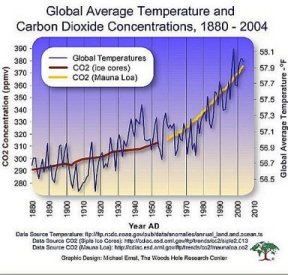
In this lesson, students will examine three claims made about global warming: (1) global warming has not occurred since the industrial revolution, (2) the main cause of global warming since the industrial revolution has been natural changes in the amount of solar radiance from solar flares, and (3) the main cause of global warming since the industrial revolution has been an increase in greenhouse gases. Students will use quantitative figures to critically evaluate each claim and they will decide which claim is best supported by the information in the figures. Students will interpret and analyze graphs and figures and then evaluate the reliability of the information in the figures. Students will then evaluate the relevancy of each piece of information as it relates to the claims made and then students will make inferences to decide which claim is best supported by the evidence.
At the conclusion of the lesson, students will be able to:
- Explain the main factors controlling climate and how changes in these factors would impact the earth’s climate.
- Know what the current data on the causes of global warming show.
- Communicate their position on global warming using evidence.
Resources:
Lesson plan created by GK-12 Fellow Nick Ballew, 2011
Students will learn essential part of the experimental design (replication, randomization, and control). This will be especially useful for students conducting independent projects. Students will also learn how to present their scientific findings and practice by critiquing scientific posters. This lesson should be used in conjunction with any classroom experiment or science fair project.
At the end of the lesson, students will be able to:
- Design experiments (randomization, replication and control)
- Communicate scientific findings (general structure)
- Make a poster
- Evaluate posters constructively
Resources:
- Lesson Plan
- Scientific Communication Presentation
- Scientific Poster Evaluation Form
- Grading Rubric for Posters
Lesson plan created by GK-12 Fellows Tyler Bassett and Tomomi Suwa, 2011
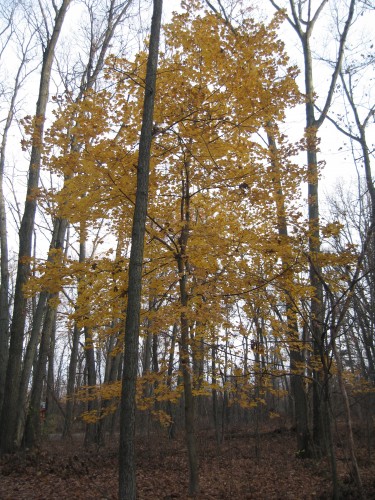
Invasive tree Norway maple, growing near KBS
Invasive species are non-native, introduced species that have a negative impact on the habitats they invade. Invasive species can be plants, animals, or microorganisms, and the damage they can cause to native ecosystems can be devastating. What is it about these species that allow them to successfully invade different habitats? Does the environment itself also play a role in how likely it is that an invasion will take place? In this lesson plan students will explore what it means to be an invasive species. They will learn what traits make a good invader as well as what environmental conditions favor invasion. Students will also get a chance to observe and interpret graphs and figures from real world research on invasive species. Finally, students will have the opportunity to play a game that simulates an invasive species spreading through Michigan, and students have to implement different methods to control its spread.
At the conclusion of the lesson, students will be able to:
- Explain what an invasive species is and provide several local examples of invasivespecies
- Understand what traits help invasive species spread
- Understand what environmental factors facilitate invasion
- Interpret graphs and figures of real world data from several invasive species
- Understand the different methods that have been used to control the spread of invasive species
Resources:
- Lesson Plan
- Presentation Slides
- Michigan Monsters Rule Sheet
- Invasive Species Control Cards
- Michigan Monsters Follow-up Questions
- Data Interpretation Exercise; Teacher Key
- Michigan Monsters – Game Map
Lesson plan and game created by GK-12 Fellows Michael Kuczynski and Kate Steensma, 2011
Biotic resistance is the ability of a native community to keep out invasive species. Land managers want to promote biotic resistance because of the harmful effects of invasive species once they have established. Several aspects of a community might make it better able to resist invasion such as high diversity, low nutrient levels, and low disturbance. In this activity, students will be able to make and test hypothesis based on invasive species success and biotic resistance. Factors promoting biotic resistance are manipulated in our BEST Bioenergy Plots and so similar questions can be asked through this activity and the data that we will be collecting through the entire GK-12 district network.
At the conclusion of the lesson, students will be able to:
- Discuss several examples of invasive species in Michigan, and why biologists are concerned about their introduction.
- Define biotic resistance and qualities of a community that can repel or facilitate invasion.
- Link biotic resistance to the treatments that are being applied to the BEST Bioenergy plots at their school district.
- Make predictions about where we’ll find the most invasive species in the plots.
- Graph and interpret data, using evidence to support their claims.
Lesson plan created by GK-12 Fellow Elizabeth Schultheis, 2011
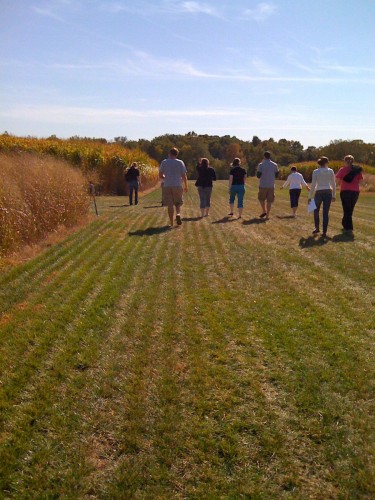
Here you will find our Fellow-developed lesson plans that relate to the three categories of protocols we’ve developed: biomass/biodiversity, landscape level, and soils. Each lesson plan takes one or more of those protocols, provides background for teachers and students, and relates the protocol to Michigan grade-level content standards.
Introducing the Plots
- Bioenergy: An Introduction – the what, how, and why of bioenergy
- What makes it all go? Can biofuels do the job?
- Lesson Plan Part I
- Lesson Plan Part II
- Lesson Plan Part III – elementary
- Presentation Slides
- Energy Exercise – elementary
- Energy Exercise – high school
- BEST Plot Plant Biomass Data – Feb 2012
- Michigan Map
- Fuel Conversion Worksheet
- Fun with fermentation: How cellulose becomes ethanol
Plant Biodiversity Protocols
- Biodiversity: It’s all connected! – exploring biodiversity and organisms’ interactions with their environments
- How do we classify living things? Learning how to make dichotomous keys
Invertebrate Biodiversity Protocols
- Scientific Method Lesson Plan – What habitat around your school has the highest invertebrate biodiversity?
- Incredible Invertebrates! Intriguing lifestyles of the weird and spineless
- Dividends on Diversity
Soil Protocols
- Data Analysis Lesson Plan – What will you do with all these data?, Middle and High School level
- Lesson Plan
- Presentation
- LTER Data – BY REQUEST ONLY (email Tomomi Suwa <suwatomo@msu.edu>)
- Exploring patterns and drawing conclusions from data – Elementary level, invertebrate data
- Lesson Plan
- Invertebrate Handout
- Presentation
- Smart Excel File – graphs and tables
- Worksheets – for different student levels
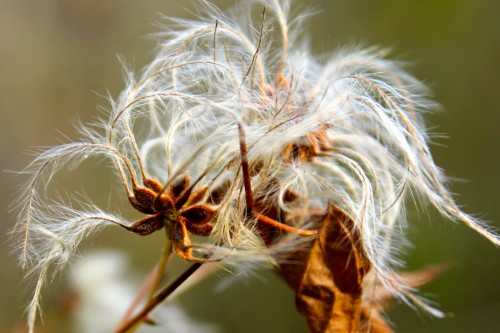 In this lesson, students will learn the characteristics that help seeds to disperse and the variety of ways that seeds can get around! Dispersal is important for plants (and animals, too) because it helps young organisms to avoid competing with their parents for resources and to escape seed predators. Different species of plants produce seeds with different adaptations for dispersal. Some seeds, like those of the dandelion, rely on the wind to carry them. Other seeds are encased in fruit, and rely on animals to eat them and deposit their seeds elsewhere. This topic connects to many K-4 topics, including organism’s needs in their environments, competition, adaptation, survival, reproduction, and plant life cycles. Additionally, this lesson helps students practice multiple important inquiry skills that encompass many steps of the scientific method.
In this lesson, students will learn the characteristics that help seeds to disperse and the variety of ways that seeds can get around! Dispersal is important for plants (and animals, too) because it helps young organisms to avoid competing with their parents for resources and to escape seed predators. Different species of plants produce seeds with different adaptations for dispersal. Some seeds, like those of the dandelion, rely on the wind to carry them. Other seeds are encased in fruit, and rely on animals to eat them and deposit their seeds elsewhere. This topic connects to many K-4 topics, including organism’s needs in their environments, competition, adaptation, survival, reproduction, and plant life cycles. Additionally, this lesson helps students practice multiple important inquiry skills that encompass many steps of the scientific method.- Describe different adaptations seeds have that help them to disperse
- Make predictions about how a seed is likely to disperse
- Collect data and record findings in simple charts
- Summarize data from charts into sentences
- Compare findings among types of seeds
- Compare findings between groups that may have tested the same or different types of seeds
- Recognize that repeating a test should provide similar results to previous tests
Resources:
Lesson plan created by GK-12 Fellows Elizabeth Schultheis & Alycia Lackey, 2011
These materials can be a guide for exploring nature, with focus on Michigan species. Use the scavenger hunt to help your students identify particular types of organisms and organism-environment interactions. The “picture review” shows how Jim Eckert’s class at Wattles Park Elementary School in Harper Creek exploring the Ott Biological Reserve. The “tree identification” and “animal tracks” documents focus on Michigan species your students might be able to find.
Enjoy the outdoors!
Resources:
- Forest Walk Scavenger Hunt Worksheet
- Tree identification guide (by leaves)
- Animal Tracks in Michigan Guide
- A picture review of one class’s visit!
Field trip idea by GK-12 Fellow Alycia Lacky
Students explore the effects of the environment on competition between species. Students play a game where two different species forage for prey. Species differ in vision, simulated by light-filtering goggles, which affects their
ability to forage on particular food items that differ in color. Students gather data, make tables and graphs, and make comparisons between outcomes for different species and in different environments. Students develop new
questions to test within the framework of the game. They make predictions, develop methods, gather data and interpret results from their questions. Connections to evolution, competition, predator-prey dynamics and food webs
can be made.
At the conclusion of the lesson, students will be able to:
- Understand that organisms require resources from their environment.
- Understand that organisms compete for resources in their environment.
- Become familiar with examples of competition between species.
- Understand that changes to the environment change competition between species through a game.
- Become familiar with examples of change in environments that cause change in competition between species.
- Make applications to real world situations of environmental change and competition (including applications to bioenergy plots).
- Make tables and graphs of data collected.
- Interpret data from graphs and make comparisons between graphs from different scenarios and species.
- Develop new questions, make predictions, design methods, test question, collect and interpret data.
Resources:
Lesson plan and game created by GK-12 Fellow Alycia Lackey & teachers Steve Barry and Sandy Erwin
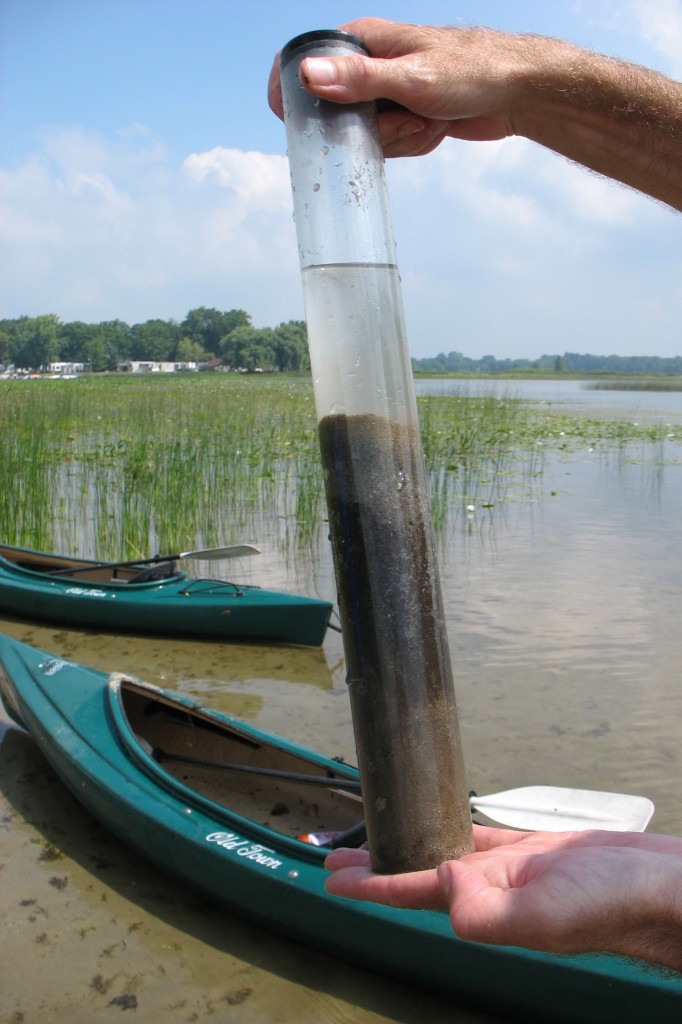 Mud, or sediment, is an active part of aquatic ecosystems. Sediment varies widely within and among ecosystems in its biotic and abiotic characteristics. In many ecosystems sediment can release excess phosphorus (a common aquatic pollutant) into the water column causing internal eutrophication
Mud, or sediment, is an active part of aquatic ecosystems. Sediment varies widely within and among ecosystems in its biotic and abiotic characteristics. In many ecosystems sediment can release excess phosphorus (a common aquatic pollutant) into the water column causing internal eutrophication
At the conclusion of the lesson, students will be able to:
- Observe and describe abiotic and biotic characteristics of sediment
- Recognize that the sediment and water in a lake carry phosphorus, which is necessary for life, but can have negative ecosystem effects at high levels
- Describe the difference between experimental control and treatment groups
- Use observations to support conclusions
Resources:
Lesson plan created by GK-12 Fellow Lauren Kinsman & teacher Liz Ratashak
In this lesson, students will examine herbivory on exotic vs. native tree species planted into plantations in the Kellogg Forest. We will use our data to test the Enemy Release Hypothesis, which posits that exotic species escape from specialized natural enemies in their invaded range, contributing to their success. Students
will develop predictions, design experimental sampling methods, collect data, and create graphs to summarize data.
At the conclusion of the lesson, students will be able to:
- Give reasons why invasive species are so successful in their introduced range and can displace native species
- Compare ecosystem processes acting on native and exotic species
- Identify new plants species and different types of herbivore damage
- Present data in visual format for interpretation
Resources:
Lesson plan created by GK-12 Fellow Elizabeth Schultheis & teacher Marcia Angle, 2010
Biofuel crops are being considered as an option for reduction of global warming. However, biofuel crops are not 100% carbon neutral. There are three agriculture related greenhouse gases: carbon dioxide, methane, and nitrous oxide, N2O. Nitrous oxide is an important greenhouse gas that is often overlooked by the non scientific community. 60% of nitrous oxide emissions are produced by agriculture ecosystems. Input of fertilizer greatly stimulates nitrous oxide emissions.
At the conclusion of the lesson, students will be able to:
- Describe certain processes in nitrogen cycling (specifically, denitrification, nitrification)
- Understand that an increase in fertilization of biofuel crops will increase the release greenhouse gases
- Know how nitrous oxide can counteract the greenhouse gas reduction effects of using biofuels as a means of reducing greenhouse gas emissions
Resources:
Lesson plan created by GK-12 Fellow Leilei Ruan & teacher Sandy Erwin
This lesson will span both Middle and High School Michigan Standards making connections to wetland ecosystems and natural selection. Students explore gray treefrog morphology and behavior, focusing on how these frogs are adapted to their environment. Students will be asked to describe their preconceptions of what makes a frog. Students will engage in an activity demonstrating what a frog needs to survive in the wild. Students will also examine several species of MI frogs taking notes of their similarities and differences and learning to identify the calls of MI frogs. Finally, students will also play a card game simulating the pros and cons of different reproductive strategies.
At the conclusion of the lesson, students will be able to:
- Identify food chains and food webs in a wetland incorporating the Michigan gray treefrogs
- Understand how the environment and human activity can influence populations.
- Understand that all plants and animals have a definite life cycle, and adaptations to accomplish specific life functions.
- Understand that inherited traits can be influenced by changes in the environment and by genetics
- Understand that characteristics of mature animals may be inherited or acquired and that only inherited traits are passed on to their young.
- Understand that there are different strategies that can be used to try to maximize reproduction
Resources:
- Lesson Plan
- Frog survival game instructions
- Life history gambling game instructions
- Sounds of selection pretest/post-test
- Sounds of selection powerpoint
Lesson plan created by GK-12 Fellow Mike Kuczynski & teacher Marty Green, 2011
- Example graph from the activity
Students participate in an activity that models natural selection or the introduction of an invasive species by competing for limited “resources,” and observing how the presence of an advantageous trait can change the class population over time. Students graph the population’s change over time and participate in a guided discussion about factors that may influence natural selection.
At the conclusion of the lesson, students will be able to:
- Describe the effects of natural selection on a population, or the effects of an invasive species on a native population
- Understand the factors contributing to extinction, including displacement and competition
- Discern patterns of population growth, including exponential growth and the relationship between a population’s environment and its carrying capacity
- Construct and interpret graphs relating to population growth
- Relate patterns to theory
- Use evidence to reason and draw conclusions
- Differentiate between a theory, hypothesis, and observation
Resources:
Lesson plan created by GK-12 Fellow Kate Steensma & teacher Marty Beuhler, 2011
Students will learn about the mutualistic relationship between plants and nitrogen fixing bacteria. The effect of environmental conditions on this relationship will be investigated in two inquiry activities.
At the conclusion of the lesson, students will be able to:
- Define mutualism.
- Describe the mutualistic relationship between nitrogen fixing bacteria and legumes. (biotic interactions)
- Describe how changing environmental conditions can alter the relationships between organisms. (abiotic interactions)
Resources:
- Lesson Plan
- Student Handout
- Assessment
-
The American Biology Teacher paper based on this exercise
- Supplementary Material1: Student Worksheet on plant-rhizobia mutualism
- Supplementary Material 2: PowerPoint presentation on plant-rhizobia mutualism
Lesson plan created by GK-12 Fellow Tomomi Suwa & teacher Sandy Breitenbach, 2012. Last updated: September 2015
In this lesson and game, students will learn about invasive species in Michigan, characteristics that make species good invaders, factors that can influence plant community assembly, and the role that people play in causing and proliferating invasions.
At the conclusion of the lesson, students will be able to:
- Provide examples of invasions causing economic and ecological concerns in Michigan
- Identify characteristics (traits) that are common among many invasive species
- Present information on the role that people play in the establishment and spread of invasive species
- Recognize some common native and invasive plant species in Michigan
- Talk about populations, communities, and the niche
Resources:
- Invasive Species Game – Lesson Plan
- Invasive Species of Michigan – Intro Powerpoint
- Species Cards – to make your own copy of the game
- Event Spinner & Stage Signs – to make your own copy of the game (some assembly required)
Lesson plan and game created by GK-12 Fellows Elizabeth Schultheis & Melissa Kjelvik, 2010
KBS GK-12 Fellows spend at least a year in the classroom of a KBS K-12 Partnership Partner Teacher. Over the course of the year they design and present lessons to students in their partner classes with guidance from their partner teachers, and present concurrent sessions to teachers at our KBS K-12 Partnership school-year workshops. We’ve posted some of our favorite fellow-produced lessons for you to enjoy. They may be related to fellow research, based on a suggestion or request made by one of our partner teachers, or produced for use on our BEST Research Network schoolyard plots. Lessons can be viewed either individually, by scrolling down this page, or by using our New Interactive Table. Feel free to contact the fellow who designed the lesson with further questions and for lesson-related materials – you can find their contact information here.
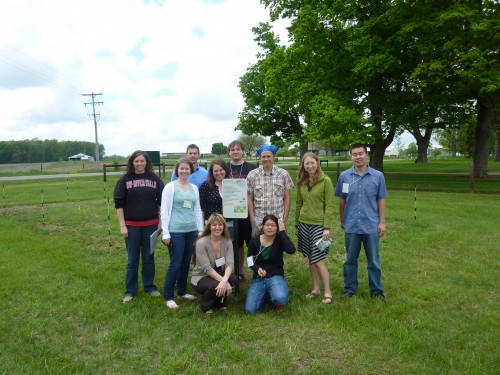 We’re looking for a few good teachers! In 2012-2013 our GK-12 project will support 9 Graduate Student Fellows who will spend approximately 10 hours per week in one of our KBS K-12 Partnership school districts. Fellow-Teacher partnerships offer graduate students an opportunity to bring leading-edge research practices and findings to K-12 learning settings. Graduate Student Fellows are meant to serve as role models to K-12 students and help stimulate their interest in STEM disciplines. We are currently accepting applications for the role of “Partner Teacher”. Partner Teachers are paired with a Graduate Student Fellow and are responsible for managing project and fellow activities in their district for a given semester or year. The general expectations are that GK-12 Partner Teachers be active participants in the KBS K-12 Partnership, including workshops and institutes, and in research and educational activities associated with the BEST (BioEnergy SusTainability) Schoolyard Research Network. To learn more, contact Robin Tinghitella and Tom Getty via kbsgk12project@kbs.msu.edu. Applications are available here. Review of applications will begin April 12th, 2012.
We’re looking for a few good teachers! In 2012-2013 our GK-12 project will support 9 Graduate Student Fellows who will spend approximately 10 hours per week in one of our KBS K-12 Partnership school districts. Fellow-Teacher partnerships offer graduate students an opportunity to bring leading-edge research practices and findings to K-12 learning settings. Graduate Student Fellows are meant to serve as role models to K-12 students and help stimulate their interest in STEM disciplines. We are currently accepting applications for the role of “Partner Teacher”. Partner Teachers are paired with a Graduate Student Fellow and are responsible for managing project and fellow activities in their district for a given semester or year. The general expectations are that GK-12 Partner Teachers be active participants in the KBS K-12 Partnership, including workshops and institutes, and in research and educational activities associated with the BEST (BioEnergy SusTainability) Schoolyard Research Network. To learn more, contact Robin Tinghitella and Tom Getty via kbsgk12project@kbs.msu.edu. Applications are available here. Review of applications will begin April 12th, 2012.
The KBS GK-12 Bioenergy Sustainability Project is accepting applications for graduate student fellowships for 2012-13. This graduate training project is funded by grant from the NSF Division of Graduate Education.
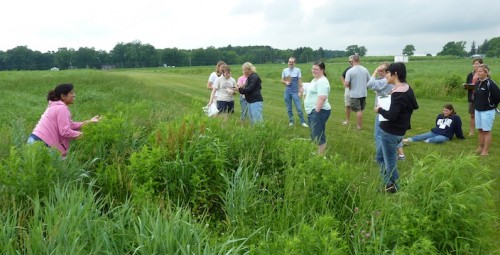 The NSF GK-12 program is meant to advance the professional development of STEM graduate students while they continue to make good progress on their dissertation research. NSF stipulates that fellows will spend a maximum of 15 hours per week directly involved in GK-12 project activities, with approximately 10 of these hours devoted to activities in K-12 partner districts or at KBS. KBS activities will include a one-day orientation in May, an intensive summer science institute in late June, four one-day school year workshops and Friday fellows meetings associated with a course focused on the professional development of fellows.
The NSF GK-12 program is meant to advance the professional development of STEM graduate students while they continue to make good progress on their dissertation research. NSF stipulates that fellows will spend a maximum of 15 hours per week directly involved in GK-12 project activities, with approximately 10 of these hours devoted to activities in K-12 partner districts or at KBS. KBS activities will include a one-day orientation in May, an intensive summer science institute in late June, four one-day school year workshops and Friday fellows meetings associated with a course focused on the professional development of fellows.
Stipend support is generous and includes benefits and tuition. The eight NSF fellowships are limited to citizens, nationals or permanent residents of the United States. The MSU Graduate School will provide one additional fellowship that does not have this restriction. Appointments will run from May 1 through April 30, with the possibility of renewal for a second year. Applicants who have established research and residency at KBS will have priority.*
To apply, please submit (1) a statement of interest, (2) your current CV, and (3) a letter of support from your faculty advisor. Your statement of interest and your advisor’s letter of support should demonstrate a familiarity with the general goals and expectations of the NSF GK-12 program and the KBS GK-12 project. Questions and application materials should e-mailed to Tom Getty and Robin Tinghitella via kbsgk12project@kbs.msu.edu . Review of applications will begin December 15, 2011.
* We anticipate that a few fellowships will be available to EEBB/ESPP students whose research is not established at KBS. Campus-based fellows will need to be prepared to spend 15 hours per week working at KBS or in nearby K-12 districts.
A Brief Autumn Update on the BEST Plots Research Project from Tom Getty
I want to share some information and my excitement about our progress on the GK-12 Bioenergy Sustainability Project. We have all put in a tremendous amount of work to design and establish the BEST Schoolyard Research Network and to develop lesson plans that capitalize on the inquiry opportunities the network creates. Now the data is beginning to come in. At our next workshop we will begin some quantitative analysis of the early results.
Recall that our BEST research network is designed to mimic aspects of the Great Lakes Bioenergy Research Center (GLBRC) Sustainability Research Project. Our overarching question is “Can We Grow Our Fuel and Our Flowers and Butterflies Too?” Under this broad umbrella we can address many basic and applied issues in science and ecology. We are particularly interested in understanding whether we can have high plant productivity, which could be converted to fuel, and maintain other “ecosystem services” related to plant and animal diversity.
To address these questions, we have implemented a very ambitious experiment that in some ways goes well beyond the GLBRC design. We have three experimental control variables, each having two values: 1. Seed type: switch grass vs mixed prairie, 2. Fertilized vs not-Fertilized, and 3. Harvested vs not-Harvested. These three treatments are “crossed” to create a block of eight treatment plots.
The block of eight treatment plots is replicated 38 times in schoolyards across SW Michigan. The positions of the treatments in the blocks are varied across blocks, to “randomize away” any possible inadvertent position effects. For instance, if being on the south side increases sunshine and productivity and we always planted switchgrass on the south side, we might mistake a position effect (being on the south side increases productivity) for a treatment effect (switch grass is more productive than prairie). We “control” for this possibility statistically by having every treatment plot on the south side in half of the blocks and on the north side in the other half.
We have some replicated blocks within districts so students can see the impacts of what scientists call “random noise,” like for instance, the groundhog burrow in one of the two Delton High School blocks, and the apparently random establishment of a few very large “volunteer” mullein plants in one of the Parchment Administration Building blocks. Nature is like that and we have to deal with it when we want to draw conclusions about the effects of our experimental treatments. Imagine if we had only one block and a groundhog just happened to establish a burrow in the fertilized, un-harvested prairie plot? Would we conclude that fertilized, un-harvested prairie plots produce more groundhogs than un-fertilized, harvested prairie plots?
We also have blocks of plots replicated across 22 locations in 14 districts scattered over more than 1000 square miles. We expect the effects of our experimental treatments (seed type, fertilization, harvest) on our dependent variables (plant productivity, plant and invertebrate diversity) will depend on uncontrolled local soil and landscape variables. For instance, we might hypothesize that productivity will depend on local soil properties, and that the effects of fertilization will be greater in locations with nutrient-poor sandy soils than in nutrient-rich loamy soils. Preliminary data from Plainwell and Gull Lake suggests that uncontrolled variation in local soils and landscapes is indeed going to be an important part of our experiment and our conclusions.
These sorts of uncontrolled local soil and landscape effects highlight the value of having an integrated research network across a diversity of locations. A big challenge in drawing conclusions from scientific studies is knowing how broadly we can apply (“generalize”) the results. A familiar example of this challenge is concern about whether studies of the effectiveness of pharmaceutical drugs in mature white males tells us about their effectiveness in young African-American women. If our BEST Plots were only placed on highly productive soils like those at the GLBRC main site, we would only be able to draw conclusions about the relationship between our treatments (ex: switch vs prairie) and our dependent variables (ex: productivity) in “good corn ground.”
This is genuine research that creates an excellent opportunity to learn about experimental design, data analysis and the role of science in addressing human needs. It is also very relevant to the specific goal of determining whether we can produce bioenergy from “marginal” lands that are not being used for food production. It looks like we have an excellent sample of “marginal” land in our network, as well some highly productive sites. I’m pretty sure our network encompasses a range of conditions that far exceeds those being studied on the GLBRC main site at KBS. Data from the entire range of BEST Plot sites is invaluable. What a great opportunity!
In late November or early December, after all the Autumn protocols are completed, I will cut down all the vegetation, to tidy up the plots. Then I will “harvest” the four Harvested plots by raking the cut vegetation off of those plots. In the unHarvested plots the cut vegetation will be left to decompose and recycle. The fertilization treatment will begin next year. Next year we will probably re-seed a few of the blocks on very sandy soil because they had such poor germination last year. More on that later.
We are looking forward to many exciting discoveries and learning opportunities over the next several years. Please help us make this the BEST possible experience for everyone.
Thanks,
Tom Getty
 Fellow Tyler Bassett is spending his year working in the classrooms of two Gull Lake Middle School teachers, Jennifer Boyle and Kim Clancy. Their partnership and work with the BEST plots research network was recently highlighted in an article in the Gull Lake Communicator. Check it out here! The article is on page 8.
Fellow Tyler Bassett is spending his year working in the classrooms of two Gull Lake Middle School teachers, Jennifer Boyle and Kim Clancy. Their partnership and work with the BEST plots research network was recently highlighted in an article in the Gull Lake Communicator. Check it out here! The article is on page 8.
 In October, Robin Tinghitella, our Project Manager, gave a talk about our GK-12 project at the 2011 National Outreach Scholarship Conference, which took place in East Lansing this year. It was a joint presentation with the Lynn Sametz, Project Manager at UNC Greensboro’s GK-12 program. Both projects just finished their first year of funding. The two shared the goals of the National GK-12 Program, presented details about both GK-12 projects, and shared preliminary findings about the science communication skills of participating graduate students. We look forward to participating in NOSC in the future and to many more presentations about the success of our program. You can view the talk slides here.
In October, Robin Tinghitella, our Project Manager, gave a talk about our GK-12 project at the 2011 National Outreach Scholarship Conference, which took place in East Lansing this year. It was a joint presentation with the Lynn Sametz, Project Manager at UNC Greensboro’s GK-12 program. Both projects just finished their first year of funding. The two shared the goals of the National GK-12 Program, presented details about both GK-12 projects, and shared preliminary findings about the science communication skills of participating graduate students. We look forward to participating in NOSC in the future and to many more presentations about the success of our program. You can view the talk slides here.
![]() It’s official – data collection has begun! Students in 13 SW Michigan school districts are busy learning how to sample plant biomass, insect and plant biodiversity, characterize soil and measure soil chemicals, and survey landscape-level characteristics of their schoolyards as part of the BEST Plots Research Network. Their data will become part of a large database that students and teachers can use to address questions such as:
It’s official – data collection has begun! Students in 13 SW Michigan school districts are busy learning how to sample plant biomass, insect and plant biodiversity, characterize soil and measure soil chemicals, and survey landscape-level characteristics of their schoolyards as part of the BEST Plots Research Network. Their data will become part of a large database that students and teachers can use to address questions such as:
- Do plants yield more biomass when they are grown as a mixture of plants (prairie) rather than a monoculture (switchgrass)?
- Does the soil composition affect plant biomass when we compare across schools?
- Does fertilization impact species diversity in the mixed prairie plots?
- Does the amount of pavement near the plots versus forest or grass impact insect biodiversity?
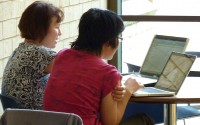 Here you will find resources for teachers and students conducting BEST Plots research.
Here you will find resources for teachers and students conducting BEST Plots research.
- Guides and Protocol Resources
- Bibliography
- Books
- Popular Press Articles
- Michigan Press Articles
- Policy Statements
- Ecological Society of America Reports
- Science News
- Scientific Articles
- Educational Resource Websites


